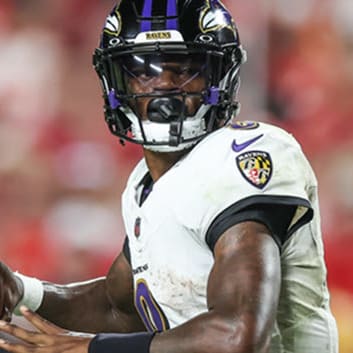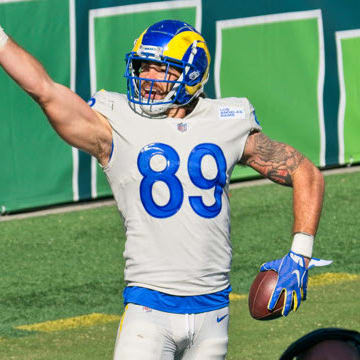This article is part of our Best Ball Strategy series.
This article will look at the current ADP on Underdog Fantasy NFL best ball drafts to identify some of the worst and best present values, naming one landmine player and then at least one suggested alternative in each case. Underdog has a variety of contest types, including one novel format where the player pool is only rookies and second-year players, but this article will focus on leagues with the entire player pool at their disposal. Such leagues go 18 rounds and use 0.5PPR scoring with 1QB/2RB/3WR/1TE/1FLEX starting lineups.
If you'd like to join one of the many best ball leagues available on Underdog, click here.
Landmine: Chris Carson, RB, SEA (34.1)
Carson is a good player and a well-rounded running back. The Seahawks made it a point to get him more pass-catching work in 2020 and he did reasonably well with it, catching 80.4 percent of his targets at 6.2 yards per target on strong volume (46 targets in 403 snaps). Carson should continue to produce reliably on a per-touch basis both as a runner and receiver, so he's not a landmine risk in the sense of poor performance. The problem is that the Seahawks showed a clear intention to limit his carry count in 2020, a change in approach dictated by the fact that Carson suffered injuries in each of the four prior seasons. Carson is a high-collision runner whose method of production entails more of a beating than other players, and the fact that Carson missed four games with injury in 2020 – make that five seasons in a row – only makes it clearer at this point. After averaging .442 carries per snap over 2018 and 2019, Carson averaged just .35 carries per snap in 2020. Between the lack of carry upside and the heightened injury risk, it's probably an optimistic projection to put Carson ahead of players like Miles Sanders (36.5), David Montgomery (40.7) and Josh Jacobs (44.3) in the Underdog draft order
Consider instead: Josh Jacobs, RB, LV (44.7)
Naming Jacobs as an alternative isn't to say he'd necessarily be worth Carson's 34.1 ADP price tag, but if Jacobs is falling to 44.7 on Underdog then it's much easier to argue for him as the preferable target. Jacobs probably isn't as good from scrimmage as Carson, and he certainly isn't as good as a pass catcher, but Jacobs' rushing workload projects to be substantially higher. Over the last two years Jacobs averaged 0.475 carries per snap – 0.125 more carries per snap than Carson last year – and at that rate Jacobs only needs 500 snaps to approach 240 carries. It's understandable that potential investors would fear for a decrease in Jacobs' 2021 carry rate following the signing of Kenyan Drake, but that's a pessimistic sort of conjecture that fails to account for the kind of coach Jon Gruden is. Gruden's football worldview is nothing like the efficiency-minded new paradigm, and he adheres to none of its assumptions.
Whereas an analytically-minded observer might say "Drake's contract is too big for a bench player," Gruden is more likely to subscribe to a truism like "You can never have enough running back depth." The cap particulars are at best lost on Gruden, assuming he ever made an attempt to care. If you assume Drake's contract means anything in particular you're already mistaken. Rather than Jacobs' play, it's likely Jacobs' injuries that led Gruden to value Drake. Jacobs' bruising style brings injury risk, and in two years he's dealt with troubles especially to his shoulder and ankle at different points, as well as a couple minor injuries Jacobs simply played through. If Jacobs gets hurt, Drake allows them to keep their initial gameplan intact, and if Jacobs stays healthy then Gruden can create snaps for Drake by taking them away from pass-catching specialist and cut candidate Jalen Richard. Richard and Devontae Booker combined for 428 snaps last year, drawing 115 carries and 44 targets. If Jacobs plays 600 snaps he would project for as much as 285 carries, and even if he does the 100-plus carries and 40-plus targets would still be on the table for Drake. There's a chance Jacobs and Drake (120.8) are both a bit underpriced.
Landmine: Ja'Marr Chase, WR, CIN (45.5)
Chase is a great prospect, not a good one. All available information unambiguously singles him out for a distinguished NFL career. His entry on the landmine list isn't to question his talent, but rather whether expectations have gotten unfairly high in his rookie year. It's difficult enough for any rookie receiver to stand out right away, even the ones who eventually turn into stars, and it's tougher yet when you're competing for targets against receivers like Tee Higgins and Tyler Boyd. Boyd is unquestionably one of the league's top slot receivers, and Higgins is already a borderline star in his own right as he heads into his second season. It wouldn't be surprising if Chase and Higgins were both considered top-five NFL receivers within a few years, so it's not fair to expect Chase to be as good in his rookie season as Higgins will be as a second-year player, especially since Chase opted out of the 2020 college season. All three receivers face the concern of quarterback Joe Burrow's recovery from last year's multi-ligament knee tear, which as a Week 11 injury leaves Burrow in a tight race against time to get ready for Week 1. The chances of Burrow playing as well this year as two years from now are not good, and that would have been true even if his injury was 'merely' an ACL tear, and from Week 1 instead of 11. These are unusually poor circumstances that Burrow is dealing with, even within the already bleak category of season-ending knee injuries. Just as importantly, Chase is going ahead of some very good players – Tyler Lockett, Cooper Kupp and Adam Thielen all are potential All-Pro types, and that's not to mention that Chase is going nearly a full round ahead of Higgins.
Consider instead: Tee Higgins (56.0)
I've already written too much about how I love the price tag for DJ Chark (70.1) on Underdog, so to change things up and perhaps add some provocation I'll make the case for Higgins specifically over Chase. I didn't go into this offseason expecting to add many shares of Higgins – as stated in the Chase blurb, I'm concerned about Burrow's knee – but if Higgins keeps seeing disrespect like this then I might have to consider making room in a couple drafts. Higgins is a beast. This is not a merely 'good' receiver prospect. Chase could be an excellent NFL receiver and still end up slightly worse than Higgins. Higgins produced convincingly as a downfield target last year despite playing with quarterbacks who couldn't throw downfield – Burrow included – so Higgins' 2020 season was his floor rather than an output at risk for regression. The Bengals completed 65.7 percent of their targets at 6.7 yards per target, yet Higgins produced well above that baseline (62.0 percent caught at 8.4 yards per target) all before turning 22 in January. That rookie season followed an outrageously productive Clemson career. Higgins' history almost exclusively consists of dominance at high volume. It's unlikely that Higgins' 2021 season is among the best in what will likely be a storied career, but if he's falling into the late fifth round then he can still be profitable this year, even if there are difficulties along the way. By contrast, Chase needs everything to go perfectly to make sense at his current price.
Landmine: Michael Pittman, WR, IND (103.4)
Pittman isn't a bum or anything, but he's still going ahead of players who are clearly better than him. There's no real basis for assuming Pittman outproduces teammates T.Y. Hilton (139.3) or Parris Campbell (145.0), let alone players like later picks Mecole Hardman, Corey Davis, DeVante Parker, or Marvin Jones. Pittman was a 23-year-old rookie last year, meaning he was already close to a finished product and a player who shouldn't benefit from the assumption of improvement from Year 1 to Year 2. Will he probably get better? Yes, but he needs to get a lot better to come close to justifying this price, and the gulf between that outcome and last year's production is too big to assume. As a prospect he was never on the level of fellow big wideouts like Tee Higgins or Kenny Golladay, yet many observers are falling for that incorrect conclusion on the basis of draft capital. Pittman drew just 0.15 air yards per snap last year, which ranked in the 18th percentile for wide receivers. He wasn't getting open anywhere near often enough to justify a starting role. His per-target efficiency (65.6 percent catch rate, 8.2 yards per target) still looked good at a glance, but that yardage average was boosted by an unsustainable YAC average of 7.1 yards after the catch per catch (94th percentile). Is Pittman a good athlete? Yes. Is he a 94th-percentile runner with the ball in his hand? No. Is he a 50th percentile runner? Maybe, but even that isn't a given. Pittman averaged 12.6 yards per catch, so on average he was only catching the ball at 5.5 yards downfield. Hilton's catch point last year averaged 10.0 yards, and Zach Pascal 8.8 yards. Pittman is the weak link in that wideout rotation until further notice.
Consider instead: DeVante Parker (113.9)
The fantasy football markets just can't seem to get Parker right. For years he was in that Sammy Watkins/Devin Funchess category as the hyped prospect who always disappointed fantasy investors, then he finally broke out properly as a late-round pick in 2019. Begrudgingly convinced following his 1,200-yard, nine-touchdown 2019, the 2020 draft markets targeted Parker in the mid rounds only to see him total 793 yards and four touchdowns. There's no doubt that Parker struggled a bit in 2020, but he still played well for his own part and was on a roughly 1,000-yard trajectory if not for two missed games. If Parker can hit nearly 800 yards in 14 games in a season where everything went wrong, then it's worth wondering why he's going nearly a round later than Pittman, who had only 503 yards in 13 games in an offense with basically no structural difficulties. Astute scouts will note that Parker was almost always an effective player even through his struggle years, almost all of which were due to injury and Adam Gase rather than failure on Parker's part. With Jaylen Waddle and Will Fuller on the field Parker should see less defensive attention than at any point prior in his career, making him not only an obviously better option than Pittman but potentially the best value among the Dolphins offense in general on Underdog.











